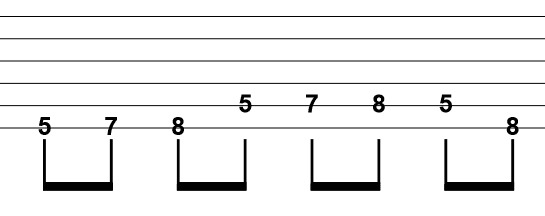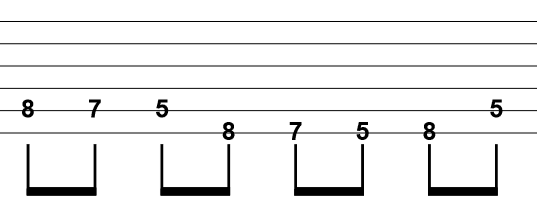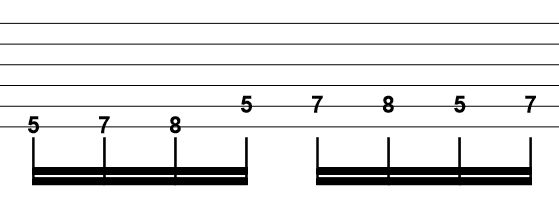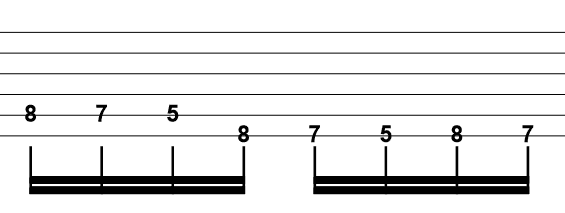
How to Make High-Speed Shred Guitar Improvisation Easy - And Take Your Shred Skills to the Max
- by Tom Boddison
- •
- 01 Jan, 2018

As a celebration of the launch of “How to Improvise Fast Shred Guitar Licks” (the massive new TomGuitar course – find out more HERE), we’re doing a free lesson featuring some of the stuff you’ll learn. Enjoy!
If there's one thing that separates wanna-be shred guitarists and the pros, it's the ability to improvise while playing really fast.
Being able to improvise on guitar is a massively important skill. It tests your scale knowledge, technique, creativity, and your ability to combine all of those skills to produce real music.
Improvisation is a great skill to have, and with a bit of practice it’s surprising how quickly you improve.
However, there’s a point at which you hit a barrier. When you’re improvising normally, you’re choosing each and every note on-the-spot – creating new music on-the-fly. However, when you start to play faster licks as you improvise, you have to stick to pre-learned patterns more and more.
This is because there isn’t time to think about all of the notes you play, because they’re going by too quickly. You have to stick to pre-learned licks, which can spoil the flow and make your improvisations all sound the same.
Improvising new, exciting things becomes more difficult the faster you play – which means that in the shred genre, it becomes very difficult to make your improvised solos sound exciting.
But wait – guys like Yngwie and Paul Gilbert can improvise at high speed, right? So why can’t we?
We need a different method – a system that allows us to improvise high-speed solos on-the-spot, creating new, unique music as we play.
The Simple Solution
When you speak, you use pre-learned words and phrases to create unique sentences.
All of the words you use are ones you’ve learned before, but the sentences you say are often unique in structure and meaning.
This is how every human being speaks, regardless of what language they use. People use little blocks of sounds that they already know (words), and combine them in new ways on-the-fly to express themselves.
How is this relevant to guitar?
Well, we can use the same strategy to play fast improvisations.
We can learn little blocks of just a few notes, and then practice combining them on-the-fly to create new, exciting shred runs every time we play. The little blocks of a few notes are our “words”, and the large licks we create by combining them are like sentences.
Creating Amazing Licks On-The-Spot
In this lesson we’re gonna go through a few simple “words” of just a few notes, and then use them to create some really awesome licks. This will create a sequence that we can use to improvise at high speed.
The idea is to learn simple little building blocks, and then combine them in a way that sounds complex but is actually really easy.
Here’s the first of our building blocks:

We’ll call this the “ascending” block.
You can play it with economy picking or alternate picking – whichever you find easiest. The important thing is that you choose one way of picking it and stick to it! Do ONE pattern of pick strokes, and stick with that one as you practice.
Otherwise it’s like you’re practising loads of different things, which will confuse your brain and slow down your progress.
Next we’re going to play the exact same thing, but reversed. Here it is:

We’ll call this the “descending” block.
Notice how all we’ve done is swap the notes around, so that the high notes are now the low notes and vice versa. This is an easy way to create another lick that we can use as a “building block” in our sequence. You’ll see how we use them both together in a moment.
First, practice those licks until you’ve got them under your fingers. These two licks are our “building blocks” that we’ll use to improvise with.
You can use them to move around the neck and up and down the strings, but first you have to learn them in one position. Don’t move on too soon!
How to Use the Building Blocks
Now you’ve learned the little blocks, we’re gonna learn to move them around.
You can use the first building block to move up the strings, like this:

Notice how we’re just repeating the ascending building block on each pair of strings as we ascend. You can do this all the way up to the high E string if you like – try it!
Try it out in different keys and different parts of the neck. This is a great way to practice the lick and improve your speed, while still keeping it interesting.
Once you’re really comfortable using it to ascend the strings, try this:

Now we’re using the descending building block to descend the strings. Again, try this out in different keys and scale positions. The more places you can play it, the more versatile your skills will be and the easier it’ll be to use these patterns when you improvise.
Now we know how to move to different strings with the sequence. But what if we want to move up the neck?
We can do that too:

There we’ve used the first building block to go up from the 12th fret to the 18th fret.
See how easy it is? All you have to do is play the block in each position, moving up one scale position each time you play it. You could move down the neck, too – the method is exactly the same.
The better you know your scales the easier this will be, so spend some time solidifying your knowledge in that area if you need to. The reverse is also true – the more you do this, the better your scale knowledge will become! Moving the building blocks around is a great way to practice moving between different shapes and positions.
This whole system is pretty simple – you just learn a couple of building blocks, and then practice moving them around the neck. When you become really good at it, you can do this on-the-fly – so you’ll just have to think “play from here to here” and your fingers will be able to do it!
How to Improvise With the Patterns
Before you start this, make sure you’re really comfortable with the patterns we’ve already covered. You should be able to play them really easily.
Now we’re gonna learn to improvise with them.
Start by choosing a key and a place on the neck – you could choose A minor around the 5th-10th frets, for example. Then, start to play the building blocks from that position, moving them up and down the strings/frets as you do so. Do it really slowly at first, so you have plenty of time to think about what you’re doing.
The only rule is this: you’re not allowed to play anything except for these chunks of notes! You have to stick to this one sequence as you improvise.
When you play, try to think about where you’re gonna go next. Are you gonna move up to the next string? Back down to the one you were just on? Move up the neck? Stay in the same position for a while?
Try to forget about the individual notes and just think about the blocks. Each block of notes should be “one thing”, because this makes it easier for the brain to digest it and then recall it when you play.

Once you’ve done that exercise for a while, start to speed up. You can use a metronome if you like, but it’s not 100% necessary. Gradually get faster over a week or two until you’re at the stage where you can improvise all over the neck at a good speed using the sequence.
Once you’re at a speed you’re happy with, it’s time for the next exercise.
Put on a backing track, and improvise as normal. Deliberately try to integrate your new high-speed improv skills into the licks you already know. It won’t sound great at first, but that’s normal – the idea here is to try things out and see what works.
Can you play a normal, slow phrase, and then go straight into the sequence? How about starting the fast improv sequence low on the neck, and then building all the way up before ending on a cool bend?
The possibilities are endless! This stage will turn out different for everyone, because everyone will have different ideas and tastes.
The basic idea is to deliberately use the fast improv building blocks even where you don’t think they’ll work. Use them more than you normally would. This will get you used to using them, so that eventually you’ll be able to use them tastefully.
Don’t worry about making mistakes – have fun, and see where it takes you!
Expanding Your Skills
Now we’re gonna learn some more patterns that’ll give you more freedom when using this system.
Here is a lick that demonstrates them:

This is basically a way to go smoothly from playing one building block to the reverse building block.
Notice the similarities between that and the blocks from before. The first eight notes of that example are here:

This is what you’d use to go from playing the normal ascending building block to playing the descending one.
Here are the second eight notes from the example above:

This is what you’d use to go from playing the descending building block to the normal ascending one.
Practice these on their own first, before using them in conjunction with what you already know. How about using the ascending block to go up all six strings, and then using the turnarounds above to switch to using the descending block, after which you can descend back down all six strings again?
See what you can create. Here’s just one example of how you can combine the building blocks effectively:

If it looks confusing, take it just eight notes at a time and make a note of which block is used where.
Here’s another, this time higher up the neck:

Notice how we’re still using the same little blocks, but we’re creating new music. We can create hundreds of new ideas just from the same little blocks, massively expanding our repertoire in a very short time.
The final stage in this system is to use the exercises in “how to improvise with the patterns” to get used to using these new turnarounds on-the-fly. After a little while it’ll be second nature, and you'll be able to improvise patterns like this with ease!
“How to Improvise Fast Shred Guitar Licks” Course
I hope you’ve enjoyed this article. This is just a tiny taster of some of the tips, tricks and strategies in “How to Improvise Fast Shred Guitar Licks”, the new course coming soon. In the full course you’ll get:
- A complete method for playing super-fast licks
on-the-fly, that change and evolve as you play them
- The super-effective practice strategy that I use
to learn the fastest shred guitar licks, and how you can use it to get insane
results
- BONUS MODULE: How to create your own practice
plans that guarantee progress and make incredible guitar playing easy
- Loads of real-world, musical examples you can
use to take your playing to the next level
- A super-easy step-by-step method for mastering
this system, allowing anyone
to learn
high-speed improvisation – no matter how “un-talented” you think you are
And a whole load more! You can find out more here. Stay tuned for the release!
Have fun, and keep rocking!